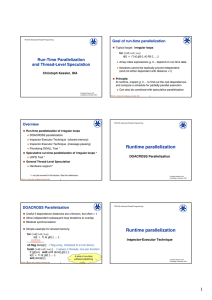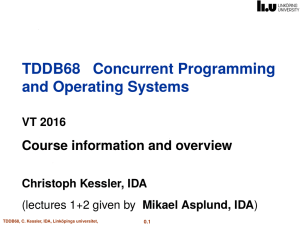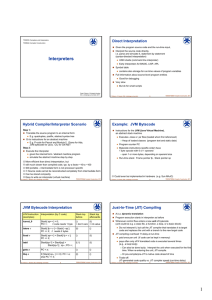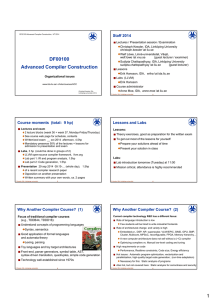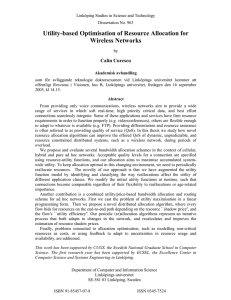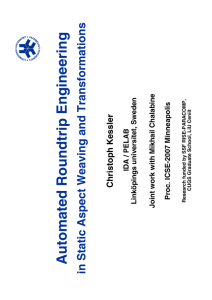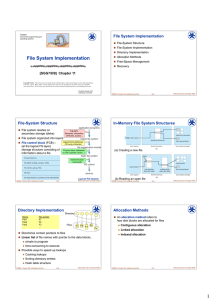Run-Time Parallelization Goal of run-time parallelization
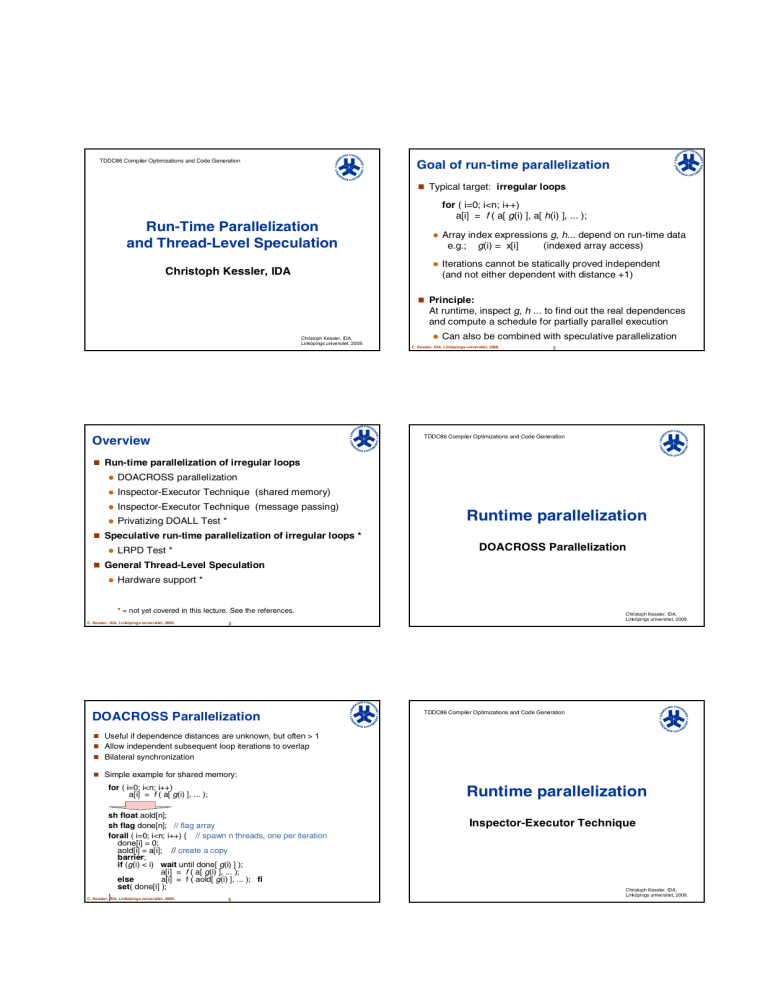
TDDC86 Compiler Optimizations and Code Generation
Run-Time Parallelization and Thread-Level Speculation
Christoph Kessler, IDA
Christoph Kessler, IDA,
Linköpings universitet, 2009.
Goal of run-time parallelization
Typical target: irregular loops for ( i=0; i<n; i++) a[i] = f ( a[ g(i) ], a[ h(i) ], ... ); z Array index expressions g, h... depend on run-time data e.g.; g(i) = x[i] (indexed array access) z Iterations cannot be statically proved independent
(and not either dependent with distance +1)
Principle:
At runtime, inspect g, h ... to find out the real dependences and compute a schedule for partially parallel execution z Can also be combined with speculative parallelization
C. Kessler, IDA, Linköpings universitet, 2009.
2
Overview
Run-time parallelization of irregular loops z DOACROSS parallelization z Inspector-Executor Technique (shared memory) z Inspector-Executor Technique (message passing) z Privatizing DOALL Test *
Speculative run-time parallelization of irregular loops * z LRPD Test *
General Thread-Level Speculation z Hardware support *
* = not yet covered in this lecture. See the references.
C. Kessler, IDA, Linköpings universitet, 2009.
3
TDDC86 Compiler Optimizations and Code Generation
Runtime parallelization
DOACROSS Parallelization
Christoph Kessler, IDA,
Linköpings universitet, 2009.
DOACROSS Parallelization
Useful if dependence distances are unknown, but often > 1
Allow independent subsequent loop iterations to overlap
Bilateral synchronization
Simple example for shared memory: for ( i=0; i<n; i++) a[i] = f ( a[ g(i) ], ... ); sh float aold[n]; sh flag done[n]; // flag array forall ( i=0; i<n; i++) { // spawn n threads, one per iteration done[i] = 0; aold[i] = a[i]; // create a copy barrier ; if ( g(i) < i) wait until done[ g(i) ] ); a[i] = f ( a[ g(i) ], ... ); else a[i] = f ( aold[ g(i) ], ... ); fi set ( done[i] );
5
TDDC86 Compiler Optimizations and Code Generation
Runtime parallelization
Inspector-Executor Technique
Christoph Kessler, IDA,
Linköpings universitet, 2009.
Inspector-Executor Technique (1)
Compiler generates 2 pieces of customized code for such loops:
Inspector z calculates values of index expression by simulating whole loop execution typically, based on sequential version of the source loop
(some computations could be left out) z computes implicitly the real iteration dependence graph z computes a parallel schedule as (greedy) wavefront traversal of the iteration dependence graph in topological order all iterations in same wavefront are independent schedule depth = #wavefronts = critical path length
Executor z follows this schedule to execute the loop
C. Kessler, IDA, Linköpings universitet, 2009.
7
Inspector-Executor Technique (2)
Source loop: for ( i=0; i<n; i++) a[i] = f ( a[ g(i) ], a[ h(i) ], ... );
Inspector: int wf[n]; // wavefront indices int depth = 0; for (i=0; i<n; i++) wf[i] = 0; // init.
for (i=0; i<n; i++) { wf[i] = max ( wf[ g(i) ], wf[ h(i) ], ... ) + 1; depth = max ( depth, wf[i] );
}
Inspector considers only flow dependences (RAW), anti- and output dependences to be preserved by executor
C. Kessler, IDA, Linköpings universitet, 2009.
8
Inspector-Executor Technique (3)
Example : for (i=0; i<n; i++) a[i] = ... a[ g(i) ] ...; i g(i)
0
2 wf[i] 0 g(i)<i ?
no
1
0
2
2
1 0 yes no
3
1
2
4
1
2
5
0
1 yes yes yes
Executor : float aold[n]; // buffer array aold[1:n] = a[1:n]; for (w=0; w<depth; w++)
3 4 forall (i, 0, n) if (wf[i] == w) { a1 = ( g(i) < i)? a[g(i)] : aold[g(i)];
... // similarly, a2 for h etc.
a[i] = f ( a1, a2, ... );
}
0
1
2
5
0
1 iteration (flow) dependence graph
C. Kessler, IDA, Linköpings universitet, 2009.
9
Inspector-Executor Technique (4)
Problem: Inspector remains sequential – no speedup
Solution approaches:
Re-use schedule over subsequent iterations of an outer loop if access pattern does not change z amortizes inspector overhead across repeated executions
Parallelize the inspector using doacross parallelization
[Saltz,Mirchandaney’91]
Parallelize the inspector using sectioning [Leung/Zahorjan’91] z compute processor-local wavefronts in parallel, concatenate z trade-off schedule quality (depth) vs. inspector speed z Parallelize the inspector using bootstrapping [Leung/Z.’91] z Start with suboptimal schedule by sectioning, use this to execute the inspector Æ refined schedule
C. Kessler, IDA, Linköpings universitet, 2009.
10
Inspector-Executor Technique (5) - DMS
Global address space (GAS) languages for DMS
(HPF, UPC, NestStep, Co-Array Fortran, ...) z Compiler must insert necessary Send / Recv operations to move data from owning to reading processor z Necessary even for (irregular) parallel loops (iterations are statically asserted to be independent, e.g. by user directive)
Can use inspector-executor method for run-time scheduling of communication in irregular loops
Inspector : z determines communication map + reverse map (schedule):
Who has to send which owned elements to whom z allocate buffer for received elements; adapt access functions
Executor : z communicates according to schedule z executes loop
C. Kessler, IDA, Linköpings universitet, 2009.
11
Inspector-Executor Technique (5) - DMS
Example : forall (i, 0, 12, #) y[i] = y[i] + a [ ip[i] ] * x[i] z y[1:n], a[1:n], ip[1:n], x[1:n] aligned and block-distributed across 3 processors P0, P1, P2 z Compiler applies owner-computes rule i owner of y[i] ip[i] owner of a [ ip[i] ]
0
P0
1
P0
1
P0
5
P1
2
P0
6
P1
3
P0
4
P1
10 0
P2 P0
5
P1
3
P0
6 7
P1 P1
4 8
P1 P2
8
P2
10
P2
9 10
P2 P2
5 4
P1 P1
11
P2
9
P2
C. Kessler, IDA, Linköpings universitet, 2009.
12
Inspector-Executor Technique (6) - DMS
Inspector step 1: construct communication map
(here, in parallel) dest
P0
P1
P2 source data
P1
P2
P0
P2
P1 a[5], a[6] a[10] a[0], a[3] a[8] a[4], a[5] local buffer area
(private) lb[0:1] lb[2] lb[0:1] lb[2] lb[0:1]
C. Kessler, IDA, Linköpings universitet, 2009.
13
Inspector-Executor Technique (7) - DMS
Inspector step 2: construct reverse communication map
(communication schedule) source
P0
P1
P1
P2
P2 dest
P1
P0
P2
P0
P1 data a[0], a[3] a[5], a[6] a[4], a[5] a[10] a[9] remote buffer area lb[0:1] lb[0:1] lb[0:1] lb[2] lb[2]
C. Kessler, IDA, Linköpings universitet, 2009.
14
Inspector-Executor Technique (8) - DMS
Inspector, step 3:
Construct modified access functions
(represented as local table of pointers) i owner of y[i] ip[i] owner of a [ ip[i] ] accesstable [i]
= where to find a[ip[i]] in local memory
0
1
1
5
2
P0 P0 P0
6
3 4 5 6 7 8 9 10 11
P0 P1 P1 P1 P1 P2 P2 P2 P2
10 0 3 4 8 10 5 4 9
P0 P1 P1 P2 P0 P0 P1 P2 P2 P1 P1 P2 a
+1 lb
+0 lb
+1 lb
+2 lb
+0 lb
+1 a
+0 lb
+2 a
+2 lb
+0 lb
+1 a
+1
Remark: Communication maps and address tables can be reused if ip[:] does not change between subsequent executions of the source loop.
C. Kessler, IDA, Linköpings universitet, 2009.
15
Inspector-Executor Technique (9) – DMS
Executor :
// send data according to reverse communication map: for each Pj in dest send requested a[:] elements to Pj
// receive data according to communication map: for each Pi in source recv a[:] elements, write to respective lb entries
// Remark: the above part can be skipped in subsequent
// executions of the executor if ip[] and a[] do not change.
// execute loop with modified access function: forall (i, 0, 12, #) y[i] = y[i] + *( accesstable[i] ) * x[i];
C. Kessler, IDA, Linköpings universitet, 2009.
16
Some references on run-time parallelization
R. Cytron: Doacross: Beyond vectorization for multiprocessors. Proc. ICPP-1986
D. Chen, J. Torrellas, P. Yew: An Efficient Algorithm for the Run-time Parallelization of DOACROSS
Loops, Proc. IEEE Supercomputing Conference, Nov. 2004, IEEE CS Press, pp. 518-527
R. Mirchandaney, J. Saltz, R. M. Smith, D. M. Nicol, K. Crowley:
Principles of run-time support for parallel processors,
Proc. ACM ICS-88 Int. Conf. on Supercomputing, July 1988, pp. 140-152.
J. Saltz and K. Crowley and R. Mirchandaney and H. Berryman:
Runtime Scheduling and Execution of Loops on Message Passing Machines,
Journal on Parallel and Distr. Computing 8 (1990): 303-312.
J. Saltz, R. Mirchandaney: The preprocessed doacross loop.
Proc. ICPP-1991 Int. Conf. on Parallel Processing.
S. Leung, J. Zahorjan: Improving the performance of run-time parallelization.
Proc. ACM PPoPP-1993, pp. 83-91.
Lawrence Rauchwerger, David Padua:
The Privatizing DOALL Test: A Run-Time Technique for DOALL Loop Identification and Array Privatization.
Proc. ACM ICS-94 Int. Conf. on Supercomputing, July 1994, pp. 33-45.
Lawrence Rauchwerger, David Padua:
The LRPD Test: Speculative Run-Time Parallelization of Loops with Privatization and Reduction
Parallelization. Proc. ACM SIGPLAN PLDI-95, 1995, pp. 218-232.
C. Kessler, IDA, Linköpings universitet, 2009.
17
TDDC86 Compiler Optimizations and Code Generation
Thread-Level Speculation
Christoph Kessler, IDA,
Linköpings universitet, 2009.
Speculative execution
For automatic parallelization of sequential code where dependences are hard to analyze statically
Works on a task graph z constructed implicitly and dynamically
Speculate on: z control flow, data independence, synchronization, values
We focus on thread-level speculation (TLS) for CMP/MT processors.
Speculative ILP is not considered here.
Task: z statically: Connected, single-entry subgraph of the controlflow graph
Basic blocks, loop bodies, loops, or entire functions z dynamically: Contiguous fragment of dynamic instruction stream within static task region, entered at static task entry
C. Kessler, IDA, Linköpings universitet, 2009.
19
Speculative execution of tasks
Speculation on inter-task control flow z After having assigned a task, predict its successor task and start it speculatively
Speculation on data independence z For inter-task memory data (flow) dependences conservatively: await write (memory synchronization, message) speculatively: hope for independence and continue (execute the load)
Roll-back of speculative results on mis-speculation (expensive) z When starting speculation, state must be buffered z Squash an offending task and all its successors, restart
Commit speculative results when speculation resolved to correct z Task is retired
C. Kessler, IDA, Linköpings universitet, 2009.
20
TLS Example Data dependence problem in TLS
C. Kessler, IDA, Linköpings universitet, 2009.
Exploiting module-level speculative parallelism
(across function calls)
Source : F. Warg: Techniques for Reducing Thread-Level Speculation Overhead in Chip Multiprocessors. PhD thesis, Chalmers TH, Gothenburg, June 2006.
21
C. Kessler, IDA, Linköpings universitet, 2009.
Source : F. Warg: Techniques for Reducing Thread-Level Speculation Overhead in Chip Multiprocessors. PhD thesis, Chalmers TH, Gothenburg, June 2006.
22
Selecting Tasks for Speculation
Small tasks: z too much overhead (task startup, task retirement) z low parallelism degree
Large tasks: z higher misspeculation probability z higher rollback cost z many speculations ongoing in parallel may saturate the resources
Load balancing issues z avoid large variation in task sizes
Traversal of the program’s control flow graph (CFG) z Heuristics for task size, control and data dep. speculation
C. Kessler, IDA, Linköpings universitet, 2009.
23
TLS Implementations
Software-only speculation z for loops [Rauchwerger, Padua ’94, ’95] z ...
Hardware-based speculation z Typically, integrated in cache coherence protocols z Used with multithreaded processors / chip multiprocessors for automatic parallelization of sequential legacy code z If source code available, compiler may help e.g. with identifying suitable threads
C. Kessler, IDA, Linköpings universitet, 2009.
24
Some references on speculative execution / parallelization
T. Vijaykumar, G. Sohi: Task Selection for a Multiscalar Processor.
Proc. MICRO-31, Dec. 1998.
J. Martinez, J. Torrellas: Speculative Locks for Concurrent Execution of Critical
Sections in Shared-Memory Multiprocessors. Proc. WMPI at ISCA, 2001.
F. Warg and P. Stenström: Limits on speculative module-level parallelism in imperative and object-oriented programs on CMP platforms. Pr. IEEE PACT 2001.
P. Marcuello and A. Gonzalez: Thread-spawning schemes for speculative multithreading. Proc. HPCA-8, 2002.
J. Steffan et al.: Improving value communication for thread-level speculation.
HPCA-8, 2002.
M. Cintra, J. Torrellas: Eliminating squashes through learning cross-thread violations in speculative parallelization for multiprocessors. HPCA-8, 2002.
Fredrik Warg and Per Stenström: Improving speculative thread-level parallelism through module run-length prediction. Proc. IPDPS 2003.
F. Warg: Techniques for Reducing Thread-Level Speculation Overhead in Chip
Multiprocessors. PhD thesis, Chalmers TH, Gothenburg, June 2006.
T. Ohsawa et al.: Pinot: Speculative multi-threading processor architecture exploiting parallelism over a wide range of granularities. Proc. MICRO-38, 2005.
C. Kessler, IDA, Linköpings universitet, 2009.
25

